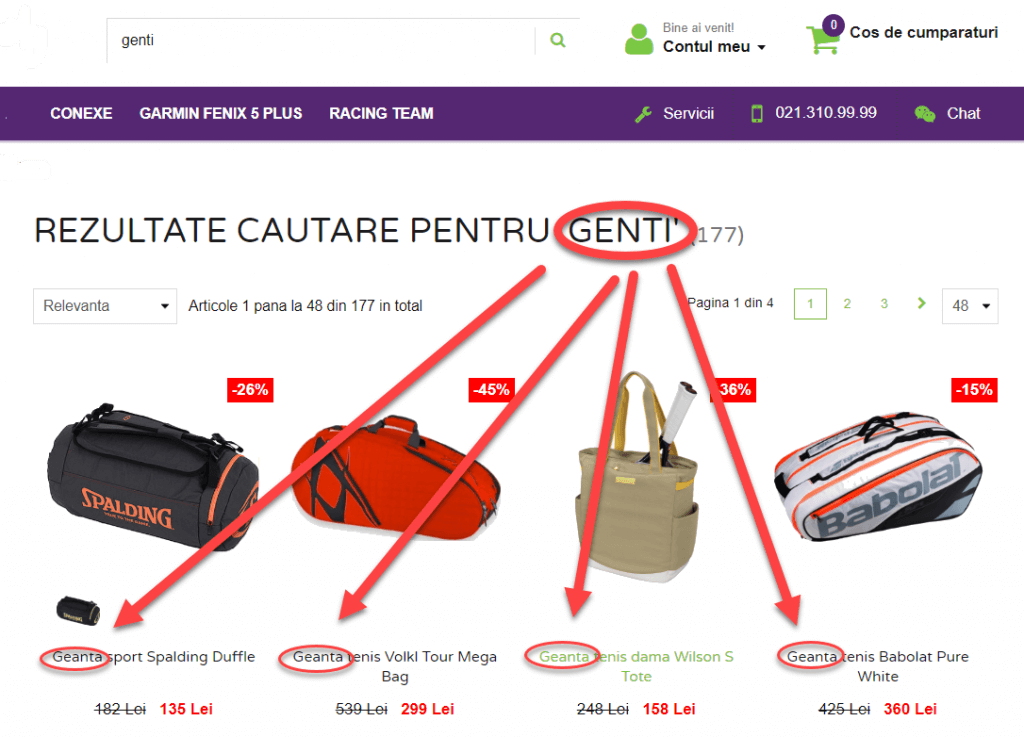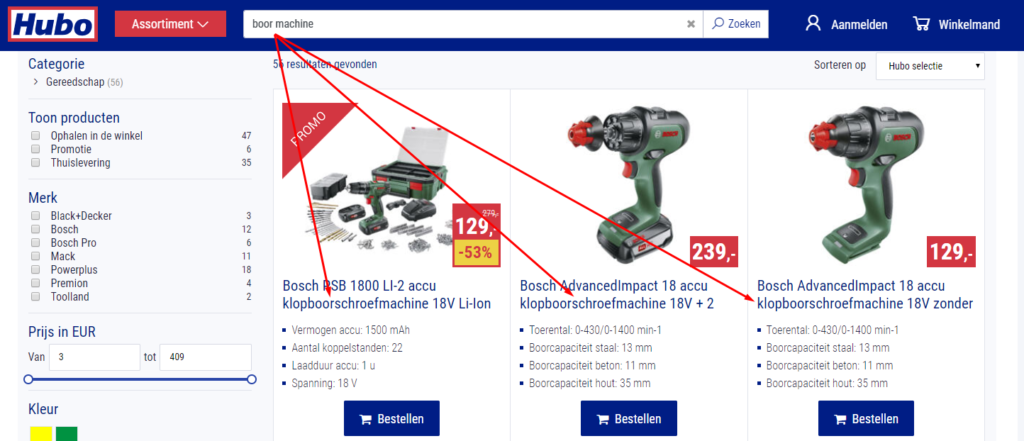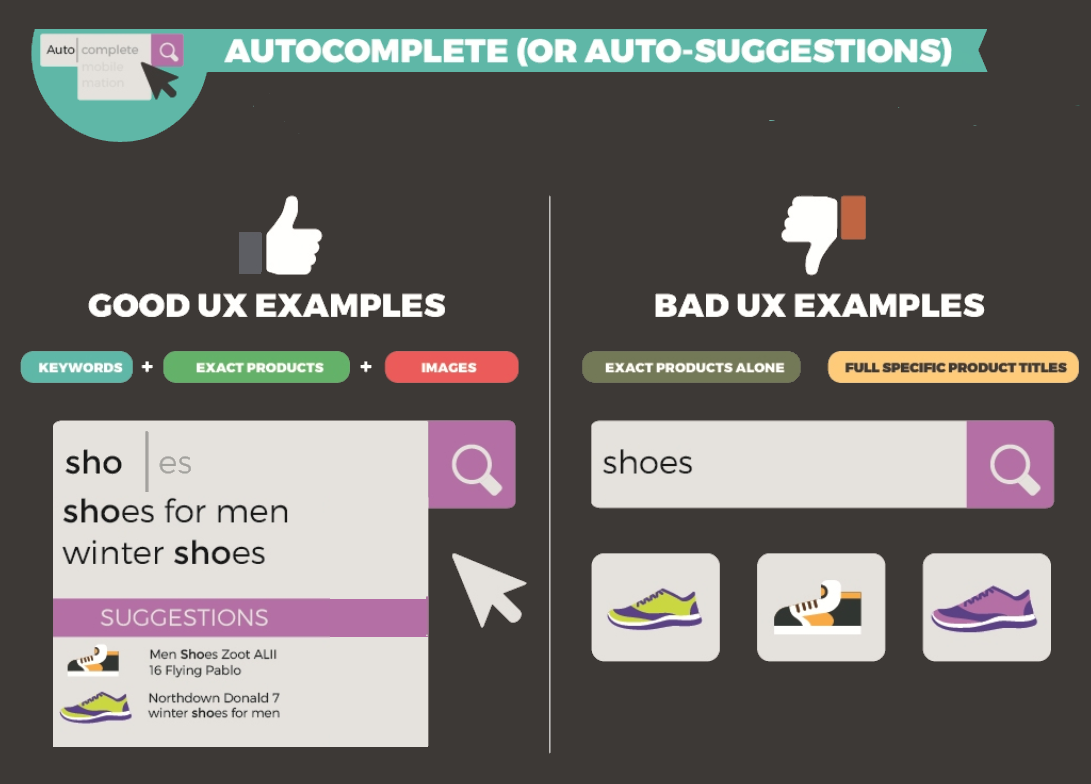18 Ecommerce Site Search Best Practices For 2021
You may think that an eCommerce site’s overall success or failure hinges on things like product selection or order fulfillment speed. But while those are important, they are nevertheless pale compared to the true backbone that power the user’s shopping experience: eCommerce search.
And although it’s relatively simple to get an eCommerce search engine up and running, the real test is in its operation. How well does the search engine understand your visitors’ input? Does it super quickly retrieve results? How accurate are the results it displays?
We’ll walk through the leading eCommerce site search best practices, trends, and growth hacks gathered from global online retail leaders and our experience.
Table Of Contents
What Is Modern Ecommerce Search?
Why Is Ecommerce Search So Important?
How to Improve Ecommerce Search – Best Practices With Recent Trends And Examples:
- How Natural Language Processing Improves Search Accuracy And Understanding
- Data Processing Plays A Big Role In Ecommerce Search Experience
- Distinguish Between Synonyms
- Transliteration To And From Other Alphabets
- Anticipating The User’s Search With Autocomplete/Autosuggest
- Accommodate Typos With Spellcheck
- No Zero Results Page
- Optimized For Mobile Search
- Contextual Filtering For Easier Prioritization Of Products
- Merchandising Your Search Results
- AI Assistant
- Personalized Ecommerce Search
- Ecommerce Search Performance That Can Adapt Based On Analytics Data
- Delivering Results Quickly
- Voice Search
- Image Search
- Improving Ecommerce Search Is A Continuous And Ongoing Process
- Auditing Search Regularly
Does Your Ecommerce Site Search Do All of This?
What Is Modern Ecommerce Search?
Ecommerce has fundamentally transformed the way we shop. With new technologies being continuously introduced, users get pickier and pickier on what they expect from online retailers. And oh boy, they expect a lot – a recent Forrester study showed that 8 out of 10 users LEAVE the online store if it failed to provide its customer with convenient website navigation, relevant results, or clear product information. Most likely, they will never come back.
Let’s face it once and for all – eCommerce search is not easy. It’s naive to expect that a simple integration will do a good job. If you wish to create enjoyable online shopping experiences that generate an ongoing revenue stream, it’s not enough to have a simple keyword-based generic search engine with simple features.
Modern eCommerce search goes beyond the search box. A genuinely effective solution should include such features as navigation (dynamic filters and facets), intelligent autocomplete suggestions, NLP and custom stemming algorithms, advanced analytics, and dashboard, proactive assistance, personalization, A/B testing. Moreover, it should also have smart ranking and data relevance algorithms, enriched with artificial intelligence and machine learning, to continually study your users’ behavior and to automate and remove the need for manual labor. And that’s not the end of the list; we could go on for hours.
Even more, great features and technologies are just the first part of a modern eCommerce search solution – if you desire to see growth in results, you need to be always working on it. It’s not enough to integrate search engine – once you stop improving it, you will see the quality (and your conversions) drop.
Why Is Ecommerce Search So Important?
When you are building (or working on) a digital commerce business, there is so much technology and features to invest in. Naturally, you may think, is it really worth investing time and money in your on-site search? Well, any features and new technologies are great, but they should generate sales first and foremost. And eCommerce search could be that money-making machine.
Don’t believe us? Let’s look into numbers:
- Research shows that site search functionality is used by 1/3 of ALL online store visitors.
- Don’t forget that visitors, who use search, are coming with clear intent – they have a conversion probability up to 6 times higher.
- Based on SearchNode internal data, searchers generate ~30-60% of ALL eCommerce site revenues!
We highly recommend analyzing your situation before making any decision. As always, in the decision-making process, data helps a lot. For online retail, the most critical data can usually be retrieved from Google Analytics. The very first primary data to check:
- % of site visits used the site search.
- % of site transactions/revenue coming from those visitors.
- An average conversion rate of the site.
- An average conversion rate of those that use the site search.

Now you can see how much of your total revenue comes from users who use search. Usually, it’s a surprise for online retailers who didn’t know these numbers before. Although every business is different, however, these are the prevailing trends in eCommerce search statistics that we already mentioned:
- Around 30% of site sessions are with site search usage. It’s perfectly normal if this metric fluctuates around 10%-30%. But if less than 10% of site visitors are searchers, this might be affected by such things as a too-small search box, terrible user experience, or your business model where product discovery is accessible without a search. If this is the case, you should first figure out the reason why less than 10% of your sessions come from search and only then try to improve it.
- Conversion rate of sessions with site search is usually 6x higher than conversion rate of the site, even with a very mediocre search experience. Just imagine how much a difference an excellent experience can make!
- 30%-60% of site transactions usually come from sessions with the search. What a money-making machine your search is or could be, huh?
But on the other side of the spectrum, people are using their natural language and vocabulary when searching, and many eCommerce search engines still aren’t returning the results people want.

To understand where you struggles and what improvements should be made, keep an eye on these metrics:
- Queries with low CTR. You will identify queries that users type in the search box, but don’t click on retrieved search results. Pro tip: don’t focus just on the top 100 most frequent queries; all low-hanging fruits are in the long-tail.
- Queries with “next page” clicks. You will identify queries that users type, and on the search results page, go to the 2nd page. They probably didn’t find desired products on the 1st page, meaning that your eCommerce search engine failed to provide relevant enough results.
- Queries with no results. You will identify queries that don’t retrieve any results at all…
To have a process of continuous search improvements, implement a routine to check these metrics at least once per week. This will help you to understand your on-site search’s weaknesses and always be up to date. This is the most crucial of all eCommerce best practices.
Now that you have a clearer picture of how site search can make or break your eCommerce website, the next question becomes — what can you do about it?
How to Improve Ecommerce Search – Best Practices With Recent Trends And Examples
Based on the Ecommerce Trends 2021 Survey Report, 68% of industry leaders are planning to improve their search in 2021. Also, the average satisfaction for site search solutions was 3.1 out of 5 possible scores. Thus there is obviously room for improvements. So why should you snooze?
Whether you’re displeased or disappointed by the state of your current solution, or you’re in the market for an eCommerce search engine that ticks all the right conversion boxes, here are the features and best practices you’ll want to look for:
1. How Natural Language Processing Improves Search Accuracy and Understanding
Natural language processing, also called NLP or natural language processing, is a computer program’s ability to understand human speech as it is spoken. This technology’s most common uses are when you tell Amazon’s Alexa to play a song or ask Siri to call someone from your contact list.
But the field is wide open in terms of its potential. With regard to site search, NLP can be used to not only extract valuable data on consumer searches, but it can also be used to more accurately target results based on what isn’t said, in addition to what is.
Here, accuracy is of vital importance. But searches can become much more complex thanks to the nuances of language. Ideally, the eCommerce site search solution should be able to understand and differentiate between a wide variety of queries.
Below are a few of the many different results such an algorithm must juggle:

Item + attribute queries
In the example below, Farfetch.com seamlessly retrieves results based on an item + attribute query, such as women’s shoes, even though products’ titles don’t have these keywords.
Products are relevant, not mixed with accessories or other irrelevant but related products:

Singular and plural queries
Another example, from our client ConsigliosKitchenware.com, shows how their site search engine should effortlessly adapt to both singular and plural forms of a product query:

But this is just one relatively simple example.
A truly intelligent site search engine needs to understand the complexities and nuances between multiple languages, including grammar rules and structure
At Sportguru.ro, a query of a bag (geanta in Romanian) and bags (genti) needs to return the same results regardless of whether the term used was singular or plural. And it’s done automatically by algorithms, without any manual human touch:

Compound words for German and Dutch languages
These languages are complicated, and search engines often struggle to understand the user’s intent. A great example from our client Hubo.be: user searches for boor machine (drill) and finds relevant results like klopboorschroefmachine (also a drill), which is a compound word made from 4 words: klop boor schroef machine.

2. Data Processing Plays A Big Role In Ecommerce Search
Online stores have lots of searchable data: titles, descriptions, categories, attributes, reviews, internal rankings, etc. It helps the eCommerce search engine to find relevant results. However, the data should be well processed and prepared, not just indexed with the search engine.
Some of eCommerce best practices for data processing from industry leaders and SearchNode:
- Converting messy or poorly structured data into an organized structure by identifying patterns.
- Automating processes, so there is no human touch needed. Advanced data processing should work by itself 24/7 with any products.
- Cleaning, tagging, extracting and optimizing data so well that search will understand even long-tail complex queries. E.g., Asus 16gb ram gaming laptop for teenagers.
Let us give you one real-life example of great data processing advantage:
The ability to handle long and complex search queries
In the example below from Bestbuy.com, we performed a sophisticated query “lenovo 16gb ram laptops for business”. With a mediocre solution, we’d be given results that include desktop computers with 16 GB of RAM, or laptops that aren’t Lenovo brand, or those who don’t have 16 GB RAM.
Here, the site search was smart enough to return matches that included the brand name, the specified amount of memory which is technically RAM, even a label “Great for Business” and all laptops, demonstrating the search engine’s ability to juggle multiple specifications from different data fields easily.

Relevant matching: is it an attribute or the product that the user is searching for?
When the products’ data is indexed without advanced processing, bad things could happen. Here is an example from a great company Vinted but not so great search experience (which I believe they are working on!).
The user searches for a belt and finds products like dresses, trousers, or pants with a belt. The search engine didn’t distinguish belts from other products that have belts as an attribute, which is a bad search experience:

3. Distinguish Between Synonyms
In this example, from Zalando.co.uk, a user searches for a dark bomber and finds dark products: oil grey, black, blue, navy, and so on. Although keyword dark is not mentioned in the title, nor in the product page (I checked it myself), results are relevant.
This could be achieved in many different ways, from AI image recognition algorithms, which can tell the color to manual synonyms adding.
Although we are not big fans of manual synonyms adding in such cases, it’s still an option for online retailers to improve their internal search. But it’s definitely much more efficient if it is capable enough to detect synonyms automatically.

4. Transliteration To And From Other Alphabets
Transliteration to and from other alphabets is another important site search best practice for eCommerce. For example, conducting a search for a sportivnaja sumka (sports bag) on our Latvian clients’ website 220.lv allows for transliteration both to and from Russian (Cyrillic) and Roman alphabets.
Addressing this common behavior in different regions like Russia (Cyrillic) or Greece (Greeklish) allows users to use their natural writing language, find relevant products fast, and convert at the highest rates.

5. Anticipating The User’s Search With Autocomplete/Autosuggest

When you have hundreds, or even thousands of products, being able to anticipate the user’s query before they finish typing saves time and gets them to the right product faster.
Autocomplete can help. By predicting and serving products as the user types, they’ll be able to find precisely what they need rather than slogging through page after page of results.
Here, we look to the leading search and eCommerce companies for inspiration.
If you can give your users an autocomplete search experience similar to Google or Amazon, they’ll immediately feel familiar with and accustomed to searching your site.
Once the target keyword(s) are auto-completed, the system should then recommend products accordingly. This leads to a very high conversion rate, as you’ve just matched the user’s query in seconds rather than forcing them to scroll through countless results.
And if you need specific customization work done with regard to your own brand of products or other particular features, your eCommerce search solution should allow for this capability, not simply leave you feeling “stuck” with the default parameters.
A great autocomplete example by our client Castorama.pl with highlighted 4 main discovery sections: main keyword in different categories, keyword suggestions, product suggestions, and inspirational articles. What a highly converting experience!

6. Accommodate Typos With Spellcheck
Despite the user’s best efforts, sometimes typos can happen. This is particularly true concerning brand names. Even if you carry a specific brand, the results may not show for your user if there’s a spelling error.
By enabling robust spellcheck, your site search engine can correct the user as they type to maximize the chances that they’ll get the result they want.

7. No Zero Results Page
No results page is something that every online store has, and it’s not always an issue. It could be that the user is using such a complex query that no one in the world can understand. But if it’s because your site search is performing poorly, or if you don’t sell a specific product, it becomes problematic. If done right, zero results pages can be a great source of revenue as well. Great no results page should lead customers to relevant products, not empty screens.
Suppose highly related products or categories exist for the query that a user typed. In that case, the site search should detect that and suggest alternative results for the user while stating that nothing was found for that specific query. This could also include some popular products and categories; just don’t forget relevancy!
For example, in our client Decathlon.pl website, when users enter a query “Adidas buty zimowe” (“Adidas shoes for winter”), but the site doesn’t carry any Adidas winter shoes, other Adidas shoes are displayed to help users to end their searching journey successfully.




